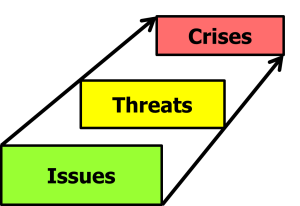When an organization has to deal with a crisis, the situation almost always feels like a bolt from the blue experience. One minute things are going along as per normal, and the next all hell breaks loose – sort of like Pearl Harbor on the morning of December 7, 1941 or the Tet holiday in January 1968.
While this reaction my appear normal, the fact of the matter is the organization facing the crisis should not feel quite so blindsided, as there are almost always advance warnings for those who choose to see them. With the benefit of hindsight organizations are able to recognize the warning signs that precede most crises. These organizations also take steps to address the factors that led to the crisis, which while necessary, is a bit like closing the stable door after the horse has bolted.
Organizations that take crisis preparation seriously focus on the issues and threats that come before the crisis, as well as the preparations for the crisis itself.
For most types of crisis there is a clear pattern of increasing danger to the organization, which can be characterized as a progression from issues to threats to crisis.
Issues are relatively long-term trends that have the potential to harm the organization at the some point in the indeterminate future. Issues may be well publicized, but they are often not immediately linked to a specific organization. As they became better understood and their causes and/or ramifications more widely recognized, they become associated with organizations and at this point they transition to become threats.
Some examples of issues that have made the jump to threats include:
- Growing evidence of the negative health ramifications of using tobacco products
- The steady increase in childhood obesity and related non-communicable diseases
- Concerns over labor practices in Southeast Asian apparel manufacturing operations
Threats are clearly associated with an organization and should be factored into its crisis planning process. Unfortunately, the most dangerous threats are those that are unrecognized. For example the increasing power and unity of OPEC was a clear threat to the US economy in the early 1970’s but this was largely unrecognized until the oil embargo of 1973. The increased quality and decreased cost of digital photography equipment posed an existential threat to traditional film manufacturers (and related industries) that remained largely unrecognized until it was too late.
For a threat to become a crisis it only requires a trigger or catalyst. This could be any one of a thousand events such as a consumer complaint, a negative media story, a new piece of legislation, an accident on the shop floor or an O-ring failure. The organizations that have taken the time to study the issues and threats relevant to their particular situation will obviously still face a crisis, but they will be infinitely better prepared to deal with it than those who truly feel that it has fallen on them in a deus ex machine fashion.
Of course, it is easy to say the organization should keep watch on both near and far horizons for issues and threats that may, one day, become a crisis, but there are significant challenges to acting on this advice. Some thoughts on how to go about environmental scanning will be covered in the next post.

